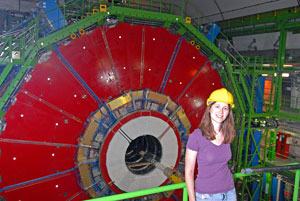Physics major writes about exploring the many cultures of Europe while researching charged particles at the CERN facility in Switzerland
 Physics major Jennifer Grab ’10 (Thornhurst, Pa.) spent her summer working with the world’s largest particle accelerator at the CERN (European Organization for Nuclear Science) facility in Switzerland. The project was sponsored by the National Science Foundation’s Research Experience for Undergraduates program.
Physics major Jennifer Grab ’10 (Thornhurst, Pa.) spent her summer working with the world’s largest particle accelerator at the CERN (European Organization for Nuclear Science) facility in Switzerland. The project was sponsored by the National Science Foundation’s Research Experience for Undergraduates program.
As a busy physics student, I am presented with very few opportunities to travel outside the United States and do research, especially to a world class institution such as CERN. Throughout the summer, I grew as a person, as a scientist, and as a traveler. My research at CERN was a valuable learning experience that has helped me shape my career goals of becoming an experimental physicist.
Situated on the border between France and Switzerland near Geneva, CERN is the largest high-energy physics laboratory in the world. It is home to the Large Hadron Collider (LHC), the most powerful particle accelerator in the world. A massive ring 26 kilometers in length, the LHC is designed to smash two protons together at speeds approaching the speed of light to produce a shower of new particles and energy. These particles are detected and analyzed by experiments situated around the ring.
The experiment with which I worked this summer was called the Compact Muon Solenoid (CMS). CMS is a general multipurpose detector developed for the LHC to test a wide range of theories from the existence of multiple dimensions to super symmetry. Physicists hope that data obtained from CMS will help us understand the universe fractions of a second after the Big Bang and explain why matter has mass. Designed to detect as many particles as possible, CMS is composed of four subdetectors — the silicon tracker, the electromagnetic calorimeter, the hadron calorimeter, and the muon chambers.
The innermost component of the CMS detector is the silicon tracker, which uses 10 million silicon strips to track the position of and calculate the momentum of charged particles, such as electrons. Since the numbers are so large, it is very important to develop an efficient way to analyze data from the tracker. My work this summer was to develop two computer programs to find noisy strips in the tracker in order to improve data quality.
Outside my work, I was traveling. Before the start of the program, I went for a two-week tour of Morocco and Spain with three other students from the REU. The trip to Morocco was at first a shock. Traveling to Marrakesh and then Tangiers, I realized the extreme poverty that many of the people endured. It was a shock when at dinner, flocks of dirty children crowded around a deserted table, gobbling down the remains of someone’s meal. At the same time, Morocco had a certain beauty to it. The mosque was visible from just about every point of town, and I was amazed by how everyone would drop everything to pray, despite the suffering in their lives. Even though the Moroccans did not have much, they made do with what was available to them.
After my arrival at CERN, I participated in a number of weekend trips around Switzerland. Since the country is sandwiched between France, Italy, Germany, and Austria, the Swiss people come from a variety of backgrounds. We traveled from French-influenced Geneva to German-speaking Zurich to traditional farmlands deep in the Alps. Even though the Swiss may seem to be disjointed culturally, they still share a staunch national pride unrivaled by many countries their size. We attended the Swiss Day celebration in Geneva, entering a maze of people, carnival rides, and food stands. The evening ended with some of the most lavish and spectacular fireworks I have ever seen. In addition to experiencing the various cultures of Switzerland, I also had the opportunity to see the Swiss Alps, which is by far the most beautiful place I have ever been. The summer was topped off with a trip to Paris, where we got to see such famous sites as the Eiffel Tower, the Louvre, and Notre Dame.
My summer at CERN was certainly an experience I will never forget. I not only gained valuable knowledge about experimental high-energy physics, computer science, and technology, but I also have been able to experience firsthand the cultures of Europe and Northern Africa. I have gained valuable insights that will stay with me for the rest of my life and have been able to find a direction for my career goals in physics.
 Physics major Jennifer Grab ’10 (Thornhurst, Pa.) spent her summer working with the world’s largest particle accelerator at the CERN (European Organization for Nuclear Science) facility in Switzerland. The project was sponsored by the National Science Foundation’s Research Experience for Undergraduates program.
Physics major Jennifer Grab ’10 (Thornhurst, Pa.) spent her summer working with the world’s largest particle accelerator at the CERN (European Organization for Nuclear Science) facility in Switzerland. The project was sponsored by the National Science Foundation’s Research Experience for Undergraduates program.